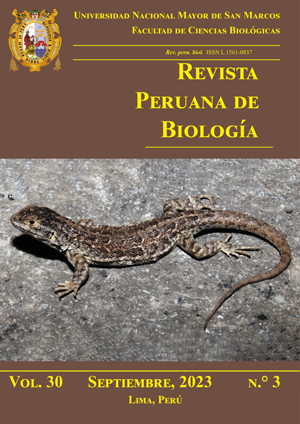Pachyoliva columellaris G.B. Sowerby I, 1825 (Olividae, Caenogastropoda) in Peru: tidal migrations and population density
tidal migrations and population density
DOI:
https://doi.org/10.15381/rpb.v30i3.24995Keywords:
population density, sandy beach, suspension feeding, tidal migration, underwater sailing locomotionAbstract
The gastropod Pachyoliva columellaris (formerly Olivella columellaris) is particularly common on many sandy beaches in North Peru. In the studied region north of Paita, Piura province, the species reaches densities of over 80000 individuals per beach meter. The snails perform tidal migrations throughout the lunar cycle although tidal amplitudes differ four-fold between neap and spring tide. Not all animals complete their tidal migrations, and significant numbers remain above the water line at low tide. Throughout the tidal cycle, the proportion of small individuals is increased near the water line whereas large animals dominate in lower beach zones. I conclude that the sandy beaches north of Paita are well-suited for further studies of P. columellaris and the mechanisms underlying tidal migrations in invertebrates.
Downloads
References
Anonymous. 2013. 2014 Tide Tables. West Coast of North America and South America Including the Hawaiian Islands. OceanGrafix, St. Paul MN (USA).
Bowers DG, Roberts EM. 2019. Tides. A very short introduction. Oxford University Press, Oxford (UK).
Brown AC. 1996. Behavioural plasticity as a key factor in the survival and evolution of the macrofauna on exposed sandy beaches. Revista Chilena de Historia Natural 69:469–474.
Gibson RN. 2003. Go with the flow: tidal migration in marine animals. Hydrobiologia 503:153–161. https://doi.org/ 10.1023/B:HYDR.0000008488.33614.62.
Gili J-M, Coma R. 1998. Benthic suspension feeders: their paramount role in littoral marine food webs. Trends in Ecology and Evolution 13:316–321. https://doi.org/10.1016/S0169-5347(98)01365-2.
Kantor YI, Fedosov AE, Puillandre N, Bonillo C, Bouchet P. 2017. Returning to the roots: morphology, molecular phylogeny and classification of the Olivoidea (Gastropoda: Neogastropoda). Zoological Journal of the Linnean Society 180:493–541. https://doi.org/10.1093/zoolinnean/zlw003.
Koepcke H-W, Koepcke M. 1952. Sobre el proceso de transformacion de la materia organica en las playas arenosas marinas del Peru. Publicaciones del Museo de Historia Natural “Javier Prado”, Seria A Zoologia 8:1–25. https://museohn.unmsm.edu.pe/docs/pub_zoologia/Publicaciones%20Zoolog%C3%ADa%20Serie%20A%20N%C2%B0%208.pdf.
McLachlan A, Brown A. 2006. The Ecology of Sandy Shores (2nd ed.). Elsevier, Amsterdam (The Netherlands).
McLachlan A, Wooldridge T, van der Horst G. 1979. Tidal movements of the macrofauna on an exposed sandy beach in South Africa. Journal of Zoology, London 187:433–442. https://doi.org/10.1111/j.1469-7998.1979.tb03379.x.
Morse AP, Peters WS. 2016. Alimentación suspensívora oportunista del gasterópodo intermareal Olivella columellaris y sus implicaciones en la regulación de las migraciones mareales. Ciencias Marinas 42:289–294. https://doi.org/10.7773/cm.v42i4.2640.
Olsson AA. 1924. Notes on marine mollusks from Peru to Ecuador. The Nautilus 37:120–130. https://www.biodiversitylibrary.org/item/34888#page/140.
Olsson AA. 1956. Studies on the genus Olivella. Proceedings of the Academy of Natural Sciences of Philadelphia 108:155–225. https://www.jstor.org/stable/4064521.
Paredes C, Huamán P, Cardoso F, Vivar R, Vera V. 1999. Estado actual del conocimiento de los moluscos aquáticos en el Perú. Revista Peruana de Biología 6:5–47. https://doi.org/10.15381/rpb.v6i1.8298.
Pastorino G, Peters WS. 2023. Radula morphology confirms the distinct status of the suspension-feeding Pachyoliva Olsson, 1956, among Olivellinae (Olividae, Caenogastropoda). The Nautilus 137:1–6.
Peters WS. 2022a. Underwater-sailing locomotion in intertidal gastropods: comparison of neotropical species. Archiv für Molluskenkunde 151:93–105. https://doi.org/10.1127/arch.moll/151/093-105.
Peters WS. 2022b. Supplementary videos for “Underwater-sailing locomotion in intertidal gastropods: comparison of neotropical species”. Zenodo 6998110. https://doi.org/10.5281/zenodo.6998110.
Peters WS. 2022c. Definition and descriptions of the two Pachyoliva species in older texts and recent identification keys. Zenodo 7023452. https://doi.org/10.5281/zenodo.7023452.
Peters WS, Pastorino G, Fiege D. 2022. Predatory suspension feeders: an unusual feeding mode switch in Olivella columellaris (Caenogastropoda: Olividae) and its possible ecological effects. Journal of Molluscan Studies 88:eyac017. https://doi.org/10.1093/mollus/eyac017.
Ramírez R, Paredes C, Arenas J. 2003. Moluscos del Perú. Revista de Biología Tropical 51(Suppl. 3):225–284. https://revistas.ucr.ac.cr/index.php/rbt/article/view/26386.
Schmidt-Nielsen K. 1984. Scaling. Why is animal size so important? Cambridge University Press, Cambridge (UK).
Schuster O. 1952. Olivella columellaris un caracol de la Playa de Los Blancos. Communicaciones de Instituto Tropical de Investigaciones Científicas, Universidad de El Salvador 4:10–13. http://ri.ues.edu.sv/id/eprint/1326/.
Seilacher A. 1959. Schnecken im Brandungssand. Natur und Volk 89:359–366.
Sowerby GB. 1825. A Catalogue of the Shells contained in the Collection of the late Earl of Tankerville. E.J. Sterling, London (UK). https://www.biodiversitylibrary.org/page/27372421.
Troost AI, Rupert SD, Cyrus AZ, Paladino FV, Dattilo BF, Peters WS. 2012. What can we learn from confusing Olivella columellaris and O. semistriata (Olivellidae, Gastropoda), two key species in panamic sandy beach ecosystems? Biota Neotropica 12:101−113. https://doi.org/10.1590/S1676-06032012000200011.
Vanagt T, Vincx M, Degraer S. 2008. Can sandy beach molluscs show an endogenously controlled circatidal migrating behaviour? Hints from a swash rig experiment. Marine Ecology 29(Suppl. 1):118–125. https://doi.org/10.1111/j.1439-0485.2008.00221.x
Downloads
Published
Issue
Section
License
Copyright (c) 2023 Winfried Peters

This work is licensed under a Creative Commons Attribution 4.0 International License.
AUTHORS RETAIN THEIR RIGHTS:
a. Authors retain their trade mark rights and patent, and also on any process or procedure described in the article.
b. Authors retain their right to share, copy, distribute, perform and publicly communicate their article (eg, to place their article in an institutional repository or publish it in a book), with an acknowledgment of its initial publication in the Revista Peruana de Biologia.
c. Authors retain theirs right to make a subsequent publication of their work, to use the article or any part thereof (eg a compilation of his papers, lecture notes, thesis, or a book), always indicating its initial publication in the Revista Peruana de Biologia (the originator of the work, journal, volume, number and date).






